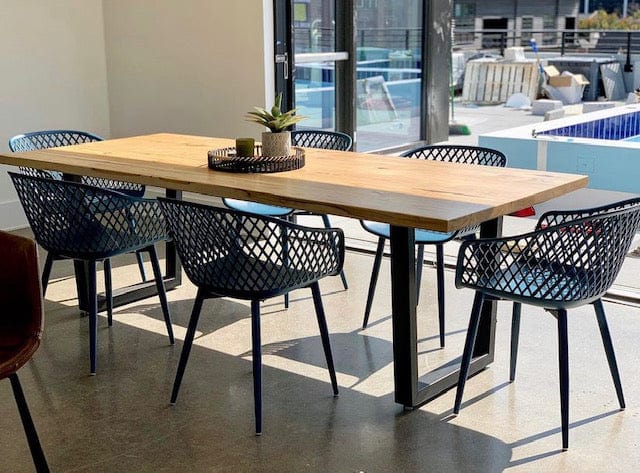Dining Room Table Legs That Integrate Functionality and Modern Design
Dining Room Table Legs That Integrate Functionality and Modern Design
Blog Article
An In-depth Check Out Dining Table Leg Styles: Locating the Perfect Match
Selecting the appropriate eating table leg style is essential for both aesthetic allure and functional functionality. Traditional 4 legs provide timeless style and stability, while the pedestal base gives boosted legroom and a modern appearance. For those with larger tables, trestle legs make certain strong support, whereas barrette legs introduce a mid-century modern-day vibe with their minimal layout. The x-shaped legs blend modern style with enhanced security. Each of these options brings special benefits, making the selection greater than just a matter of choice. Check out further to find which style flawlessly complements your eating area and way of living.
Traditional 4 Legs
Amongst the various types of dining table leg styles, the traditional four-leg design continues to be a classic selection for lots of families. Four legs provide balanced assistance, making certain the table continues to be steady and capable of bearing significant weight (dining room table legs).
From a visual point of view, the conventional four-leg design can be conveniently adjusted to various indoor designs. Whether crafted from wood, metal, or a mix of materials, these legs can be intricately sculpted, smooth and minimalistic, or anything in between. Their flexibility allows them to match both rustic and contemporary setups flawlessly.
Moreover, the uncomplicated structure of the four-leg design facilitates convenience of movement and positioning within a space. Unlike more complex bases, this design lessens obstructions, giving sufficient legroom for restaurants. In summary, the traditional four-leg table leg style marries sustaining beauty with useful functionality, making it an astute option for those looking for both form and function in their eating furnishings.
Stand Base
Frequently celebrated for its stylish and space-efficient design, the pedestal base is a prominent option to the standard four-leg arrangement in table leg designs. This distinctive base typically features a solitary main column sustaining the tabletop, which can differ in kind, from ornately sculpted wood to streamlined, modern metal. One of the main benefits of the pedestal base is its capacity to make the most of legroom and seating flexibility. Without corner legs, restaurants are afforded higher flexibility of movement, making it an optimal choice for round and oval tables that promote even more intimate and comprehensive celebrations.
The main column itself offers a canvas for detailed designs and artistic expressions, adding an element of aesthetic passion underneath the table. In summary, the stand base integrates functionality with design, making it a fine-tuned and useful choice for diverse dining settings.
Trestle Legs
Trestle legs offer a robust and ageless foundation for eating tables, defined by their straight cross-bracing and strong assistance beam of lights. Originating from medieval times, this layout has actually progressed yet preserved its crucial framework, making it a perennial fave in both standard and contemporary settings. The central trestle beam of light, usually supported by two or even more vertical posts, provides phenomenal security, enabling bigger table lengths without the demand for added legs.
A significant advantage of trestle leg Get the facts tables is the enough legroom they use. Unlike tables with four corner legs, the absence of obstructions at the table's sides gives unobstructed space for chairs and restaurants, improving comfort and ease of access. This makes trestle tables perfect for fitting larger gatherings, whether in a dining-room or a reception hall.
From rustic farmhouse to streamlined contemporary designs, trestle legs can be personalized to match private tastes. Their long-lasting allure and practical advantages make trestle legs an engaging selection for those looking for both design and practicality in their eating table.
Barrette Legs

The allure of barrette legs hinges on their simplicity and convenience - dining room table legs. Offered in a range of materials, consisting of steel and brass, they can be completed in numerous colors to complement different indoor styles. Whether coupled with a rustic wood table top or a contemporary glass surface, barrette legs easily blend performance with a touch of classic beauty
Durability is an additional significant feature of barrette legs. Despite their delicate look, these legs are crafted to birth substantial weight, guaranteeing the table continues to be secure and secure. Additionally, they are fairly simple to set up, making them a prominent selection for do it yourself fanatics and specialist furniture manufacturers alike.
X-Shaped Legs

Built from products such as steel, wood, or a combination of both, X-shaped legs can be customized to match various style choices. Steel legs typically offer a sleek and industrial feeling, ideal for loft-style apartment or condos and modern-day dining areas. On the various other hand, wood X-shaped legs provide a warmer, a lot more rustic allure, suitable for farmhouse or eclectic insides. The versatility in materials enables home owners to customize their dining tables to much better fit their total layout scheme.
Furthermore, the design behind X-shaped legs makes certain even weight distribution, lessening the danger of tottering and boosting resilience. This makes them particularly appropriate for bigger eating tables that call for added support. In significance, X-shaped legs mix useful design with modern-day looks, making them a classic choice for diverse eating atmospheres.
Conclusion
A comprehensive understanding of table leg styles exposes the unique qualities and benefits of each design. Conventional four legs supply security and ageless charm, while pedestal bases give legroom and a structured look. Trestle legs see here now guarantee robust assistance for bigger tables, and hairpin legs introduce a mid-century modern visual. X-shaped legs incorporate contemporary design with boosted security. Selecting the appropriate leg design guarantees both practical and aesthetic satisfaction in any kind of dining space.
Report this page